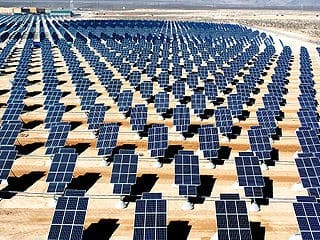It’s time to stop thinking of solar energy as a boutique source of power, says Joshua Pearce.
Sure, solar only generates about 1 percent of the electricity in the US. But that will change in a few years, says Pearce, an associate professor of electrical engineering and materials science at Michigan Technological University. The ultimate in renewable energy is about to go mainstream.
It’s a matter of economics. A definitive new analysis by Pearce and his colleagues at Queens University in Kingston, Ontario, shows that solar photovoltaic systems are very close to achieving the tipping point in many regions: they can make electricity that’s as cheap — sometimes cheaper — than what consumers pay their utilities.
Here’s why. First, the price of solar panels has plummeted. “Since 2009, the cost has dropped 70 percent,” says Pearce. But more than that, the assumptions used in previous studies have not given solar an even break.
“Historically, when comparing the economics of solar and conventional energy, people have been very conservative,” says Pearce.
To figure out the true cost of photovoltaic energy, analysts need to consider several variables, including the cost to install and maintain the system, finance charges, how long it lasts, and how much electricity it generates. Pearce and his colleagues performed an exhaustive review of the previous studies and concluded that the values given those variables were out of whack.
“It is still a common misconception that solar PV technology has a short life and is therefore extremely expensive,” he said. However, PV panels are solid-state electronic devices with no moving parts and should last a long time. “Based on the latest long-term studies, we should be doing our economic analysis on a 30-year lifetime at minimum,” Pearce said.
In addition, most analyses assume that the productivity of solar panels will drop at an annual rate of 1 percent or more, a huge overestimation, according to Pearce. “If you buy a top-of-the-line solar panel, it’s much less, between 0.1 and 0.2 percent.”
Finally, “The price of the solar equipment has been dropping, so you’d think that the older papers would have higher cost estimates,” Pearce said. “That’s not necessarily the case.” Equipment costs are determined based on dollars per watt of electricity produced. Very recent studies set the amount between $2 and $10. The true cost in 2011, says Pearce, is under $1 per watt for solar panels on the global market, though system and installation costs vary widely. In some parts of the world, solar is already economically superior, and the study concludes that solar will become an increasingly economical source of electricity over expanding geographical regions.
In regions with a burgeoning solar industry, thanks to government programs that pay a premium for renewable energy, there are lots of solar panel installers, which heats up the market. “Elsewhere, installation costs have been high because contractors will do just one job a month,” says Pearce. “Increasing demand and competition would drop installation costs considerably.”
Furthermore, economic studies like Pearce’s don’t generally taken into account solar energy’s intangible benefits, reduced pollution and carbon emissions. And while silicon-based solar panels do rely on a nonrenewable resource — sand — they are no threat to the world’s beaches. It only takes about a sandwich baggie of sand to make a roof’s worth of thin-film photovoltaic cells, Pearce said.
Based on the study, and on the fact that the cost of conventional power continues to creep upward, Pearce believes that solar energy will soon be a major player in the energy game. “It’s just a matter of time before market economics catches up with it,” he says.
The study can be found at: K. Branker, M. J.M. Pathak, J. M. Pearce, “A Review of Solar Photovoltaic Levelized Cost of Electricity”, Renewable & Sustainable Energy Reviews 15, 4470-4482 (2011). http://dx.doi.org/10.1016/j.rser.2011.07.104.


